
Mueller M.R. - Fundamentals of Quantum Chemistry[c] Molecular Spectroscopy and Modern Electronic Structure Computations (Kluwer, 2001)
.pdf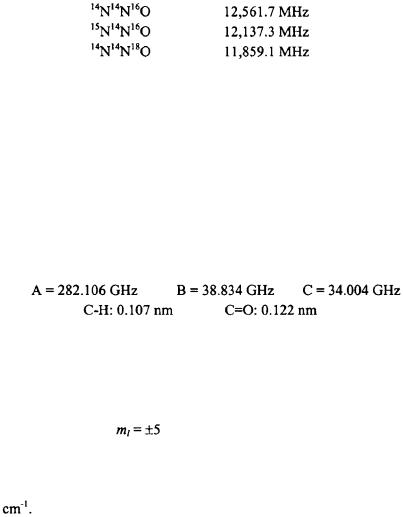
176 |
Chapter 7 |
PROBLEMS AND EXERCISES
7.1) Based on the normal modes of vibration for  shown in Figure 7-7, determine which modes are infrared active.
shown in Figure 7-7, determine which modes are infrared active.
7.2) Based on the following rotational constants for the linear molecule NNO, determine the substitution structure of the molecule.
7.3) How many normal vibrational modes will the following molecules have?  (acetylene),
(acetylene),  (ethylene),
(ethylene),  (ethylene chloride),
(ethylene chloride),  (benzene),
(benzene),  (chlorobenzene)
(chlorobenzene)
7.4) The rotational constant for  was measured to be
was measured to be  Calculate the CO bond length.
Calculate the CO bond length.
7.5) Based on the rotational constants and the bond lengths for formaldehyde  determine the bond angle.
determine the bond angle.
7.6) Classify the following molecules as asymmetric top, symmetric top, or spherical top:  benzene,
benzene,
7.7) Using second-order |
Perturbation Theory, |
confirm Equation 7-27 |
summing up to the |
rotational states. |
|
7.8) Make a sketch like that in Figures 7-4 and 7-5 of the rotational levels for a molecule with an internal degree of rotation whereby 
7.9) Find the center of mass and moments of inertia for  and
and  assuming that the bond lengths are the same as for
assuming that the bond lengths are the same as for 
Chapter 8
Atomic Structure and Spectra
In this chapter, the electronic structure of atoms will be analyzed. The simplest atom, the hydrogen atom, is an important model problem for the electronic structure of atoms. Sadly, the hydrogen atom, and other oneelectron systems, is the last model problem for which an exact solution of the Schroedinger equation can be obtained. Heavier atoms, and subsequently molecules in the next chapter, will require some degree of approximation in order to solve the Schroedinger equation. The results of the Schroedinger equation for a hydrogen atom will be used as a basis to solve for the electronic structure of heavier atoms along with obtaining an understanding of electronic spectra of atoms.
8.1 One-Electron Systems
The system described here is a two-body system (such as a hydrogen atom or a  ion): a positively charged nucleus and a negatively charged electron separated by a distance r. There is a potential between the two bodies along the radial coordinate r; however, the system is free to rotate about the angular coordinates
ion): a positively charged nucleus and a negatively charged electron separated by a distance r. There is a potential between the two bodies along the radial coordinate r; however, the system is free to rotate about the angular coordinates  and
and  Mechanically this is similar to the vibration/rotation of a diatomic molecule resulting in the same Schroedinger equation in terms of the general expression for the potential V(r) (see Section 6.2).
Mechanically this is similar to the vibration/rotation of a diatomic molecule resulting in the same Schroedinger equation in terms of the general expression for the potential V(r) (see Section 6.2).
177
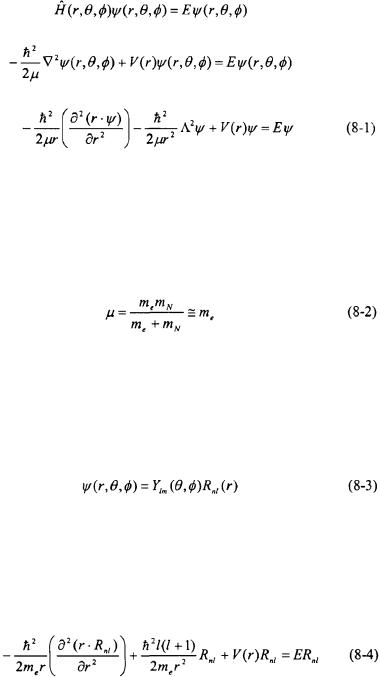
178 |
Chapter 8 |
The reduced mass,  in this system is determined from the mass of an electron,
in this system is determined from the mass of an electron,  and the atomic mass of the nucleus,
and the atomic mass of the nucleus,  However, the mass of a proton and neutron is much more massive than an electron (1836.5 and 1838.7 times more massive respectively); hence, the reduced mass for the system can be taken as the mass of an electron.
However, the mass of a proton and neutron is much more massive than an electron (1836.5 and 1838.7 times more massive respectively); hence, the reduced mass for the system can be taken as the mass of an electron.
Since the radial and angular components are separable, the wavefunction will be a product of the angular function and a radial function,  The system is free to rotate about the
The system is free to rotate about the  and
and  axes as in the Particle-on-a-Sphere model problem; hence, the angular wavefunctions are the spherical harmonics,
axes as in the Particle-on-a-Sphere model problem; hence, the angular wavefunctions are the spherical harmonics, 
To no surprise, substitution of Equation 8-3 into Equation 8-1 along with operation of  on
on  and subsequent cancellation of
and subsequent cancellation of  results in the same two-body radial Schroedinger equation as previously obtained for the vibration/rotation of diatomic molecules with a general expression for the potential V(r) (see Equation 6-10).
results in the same two-body radial Schroedinger equation as previously obtained for the vibration/rotation of diatomic molecules with a general expression for the potential V(r) (see Equation 6-10).
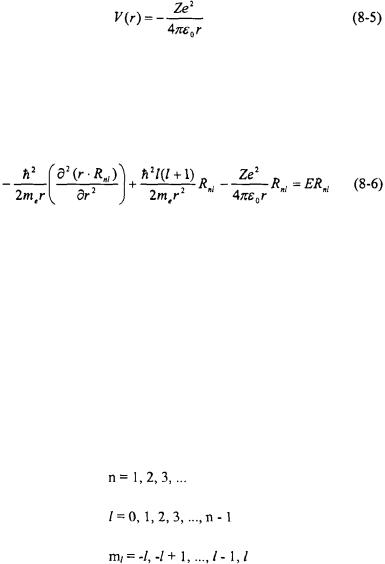
Atomic Structure and Spectra |
179 |
The potential V(r) along the radial coordinate is Coulombic. The charge of the nucleus is +Ze where Z is the atomic number and e is the elementary charge  The charge of the electron is equal to -e.
The charge of the electron is equal to -e.
The term  is the vacuum permittivity constant which in SI units is equal to
is the vacuum permittivity constant which in SI units is equal to  Substitution of Equation 8-5 into Equation 8-4 results in the following radial Schroedinger equation for a one-electron system.
Substitution of Equation 8-5 into Equation 8-4 results in the following radial Schroedinger equation for a one-electron system.
In the case of the vibration/rotation of a diatomic molecule, the  term in the radial Schroedinger equation is approximated via a power series expansion (see Equation 6-18). This approximation is sufficient for vibration/rotation of diatomic molecules because the distance of separation of the two nuclei does not vary greatly between rotational states. In the case of electronic states however, the separation of the electron and the nucleus varies widely between states and a power series expansion is inappropriate. Fortunately, the solution to Equation 8-6 is well known. There are an infinite number of solutions for each value of l and each one is designated by a quantum number n. Each state is called an atomic orbital (AO). The quantum numbers that distinguish the possible states is given as follows.
term in the radial Schroedinger equation is approximated via a power series expansion (see Equation 6-18). This approximation is sufficient for vibration/rotation of diatomic molecules because the distance of separation of the two nuclei does not vary greatly between rotational states. In the case of electronic states however, the separation of the electron and the nucleus varies widely between states and a power series expansion is inappropriate. Fortunately, the solution to Equation 8-6 is well known. There are an infinite number of solutions for each value of l and each one is designated by a quantum number n. Each state is called an atomic orbital (AO). The quantum numbers that distinguish the possible states is given as follows.
Before describing the radial functions  it is convenient to change the units. In terms of SI units, the energy eigenvalues obtained from the solution of Equation 8-6 will be in Joules. SI units are not convenient for
it is convenient to change the units. In terms of SI units, the energy eigenvalues obtained from the solution of Equation 8-6 will be in Joules. SI units are not convenient for
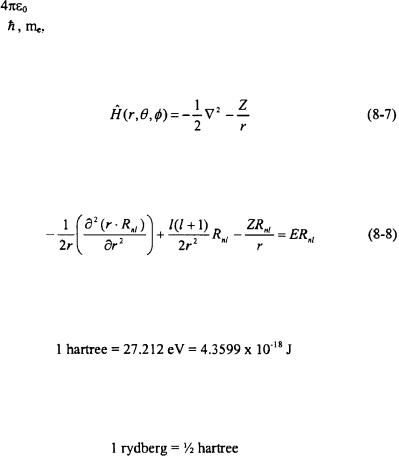
180 Chapter 8
systems at the atomic or molecular scale. Most quantum chemists report the results of their calculations in atomic units. In atomic units, the unit of mass is in terms of the mass of an electron instead of kg (i.e. the mass expressed as a dimensionless factor of the mass of the system to that of an electron:  ). The unit for angular momentum is a dimensionless factor in terms of
). The unit for angular momentum is a dimensionless factor in terms of  rather than
rather than  The radial coordinate is expressed as a ratio of the distance of separation between the electron and nucleus to the Bohr radius,
The radial coordinate is expressed as a ratio of the distance of separation between the electron and nucleus to the Bohr radius,  The Bohr radius is the distance of separation between the proton and electron in the ground-state of a hydrogen atom obtained from classical mechanics
The Bohr radius is the distance of separation between the proton and electron in the ground-state of a hydrogen atom obtained from classical mechanics  Charge is expressed in terms of a dimensionless ratio of the charge q to that of the unit charge e with the
Charge is expressed in terms of a dimensionless ratio of the charge q to that of the unit charge e with the
constant |
included. The net result of atomic units is to make the |
quantities |
and the charge q (with the combined constants) equal to 1. |
The Hamiltonian for a one-electron system with an atomic number Z in atomic units is as follows.
The radial Schroedinger equation for a one-electron system in atomic units is reduced to the following expression.
The energy eigenvalues in atomic units obtained from the solution of Equation 8-8 is expressed in hartrees (h).
Another type of atomic unit for energy that is occasionally used by chemists to report their computational results is in rydbergs.
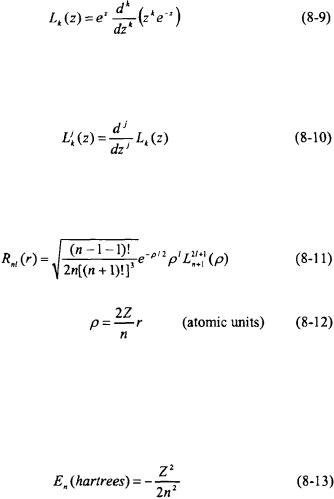
Atomic Structure and Spectra |
181 |
The radial functions  that satisfy Equation 8-8 are constructed from the Leguerre polynomials. The Leguerre polynomial of an order k can be generated from the following expression.
that satisfy Equation 8-8 are constructed from the Leguerre polynomials. The Leguerre polynomial of an order k can be generated from the following expression.
The associated Leguerre polynomials can be generated from the following expression.
The normalized radial functions  in terms of the Leguerre polynomials are expressed as follows.
in terms of the Leguerre polynomials are expressed as follows.
Table 8-1 lists the explicit form for a number of radial functions in atomic units.
The energy eigenvalues in hartrees for a one-electron system following substitution of the radial functions into Equation 8-8 are as follows.
As can be seen by Equation 8-13, the energy eigenvalues depend only on the n quantum number. Note that the energy is negative indicating that the electron remains around the nucleus by Coulombic attraction. For the ground-state of hydrogen  the energy is -½ hartree or -1 rydberg. For
the energy is -½ hartree or -1 rydberg. For  the energy for hydrogen is -1/8 hartree. As the value of n increases, the energy of the system approaches zero and the energy difference between
the energy for hydrogen is -1/8 hartree. As the value of n increases, the energy of the system approaches zero and the energy difference between
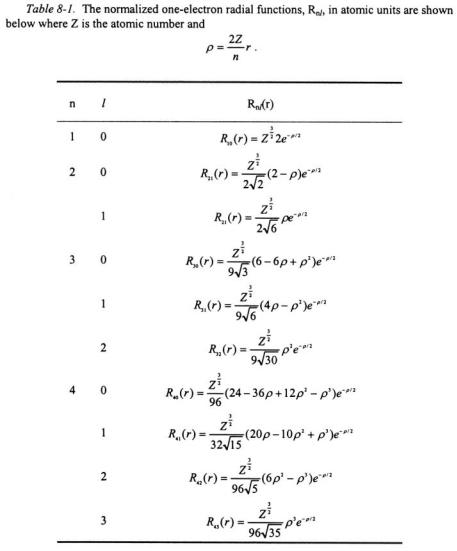
182 |
Chapter 8 |
levels becomes smaller reaching a continuum of states. The limit that n approaches infinity and the energy approaches zero corresponds to ionization. The electron at that point is completely separated from the nucleus. Since the energy of the one-electron system depends only on the quantum number n, the energy levels are degenerate. The degeneracy of each level is 
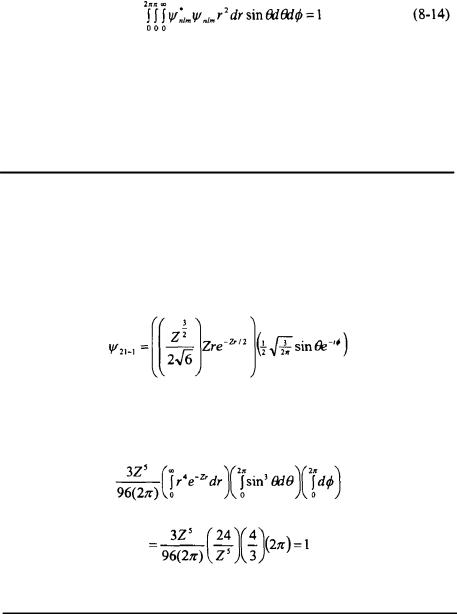
Atomic Structure and Spectra |
183 |
Setting the following integral equal to one normalizes the wavefunctions.
It is usual to normalize the angular and radial parts separately. The radial functions listed in Table 8-1 are normalized along the r coordinate, and the spherical harmonic wavefunctions in Table 3-1 are also normalized.
Example 8-1
Problem: Confirm that the  wavefunction is normalized.
wavefunction is normalized.
Solution: The  is constructed from the radial function
is constructed from the radial function  in Table 8-1 and the
in Table 8-1 and the  spherical harmonic function in Table 3-1.
spherical harmonic function in Table 3-1.
Substitution of the wavefunction into Equation 8-14 results in the following integral to be solved.
The integral is equal to one confirming that the  is normalized.
is normalized.
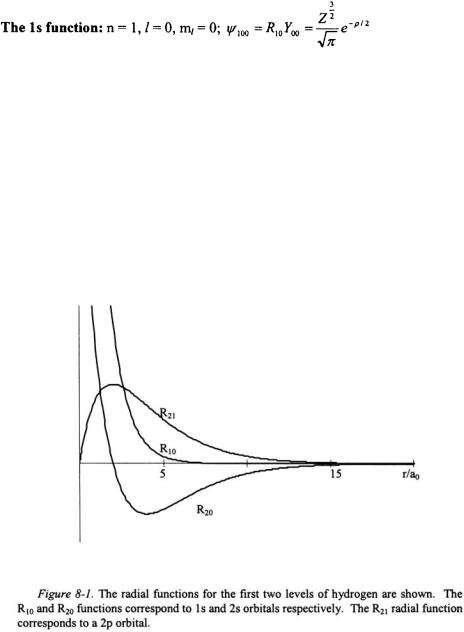
184 |
Chapter 8 |
The wavefunctions for a one-electron system and the associated radial functions can now be examined in detail. Below is a list of the first two n- states of a one-electron system.
The radial function is shown in Figure 8-1, and the radial distribution function  for this eigenstate is shown in Figure 8-2. The radial distribution peaks at
for this eigenstate is shown in Figure 8-2. The radial distribution peaks at  the Bohr radius. The radial distribution of the electron is not confined to a limited sphere around the nucleus but rather it dies away smoothly at large values of r. Since
the Bohr radius. The radial distribution of the electron is not confined to a limited sphere around the nucleus but rather it dies away smoothly at large values of r. Since  the orbital angular momentum of the electron around the nucleus is zero. This defeats the notion that the electron “orbits” around the nucleus.
the orbital angular momentum of the electron around the nucleus is zero. This defeats the notion that the electron “orbits” around the nucleus.
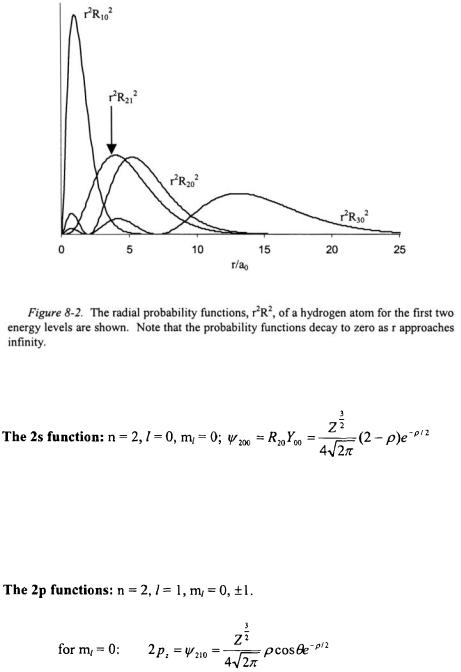
Atomic Structure and Spectra |
185 |
The radial function is shown in Figure 8-1, and the radial distribution function  for this eigenstate is shown in Figure 8-2. The radial function has one node at
for this eigenstate is shown in Figure 8-2. The radial function has one node at  representing a point of zero probability.
representing a point of zero probability.
